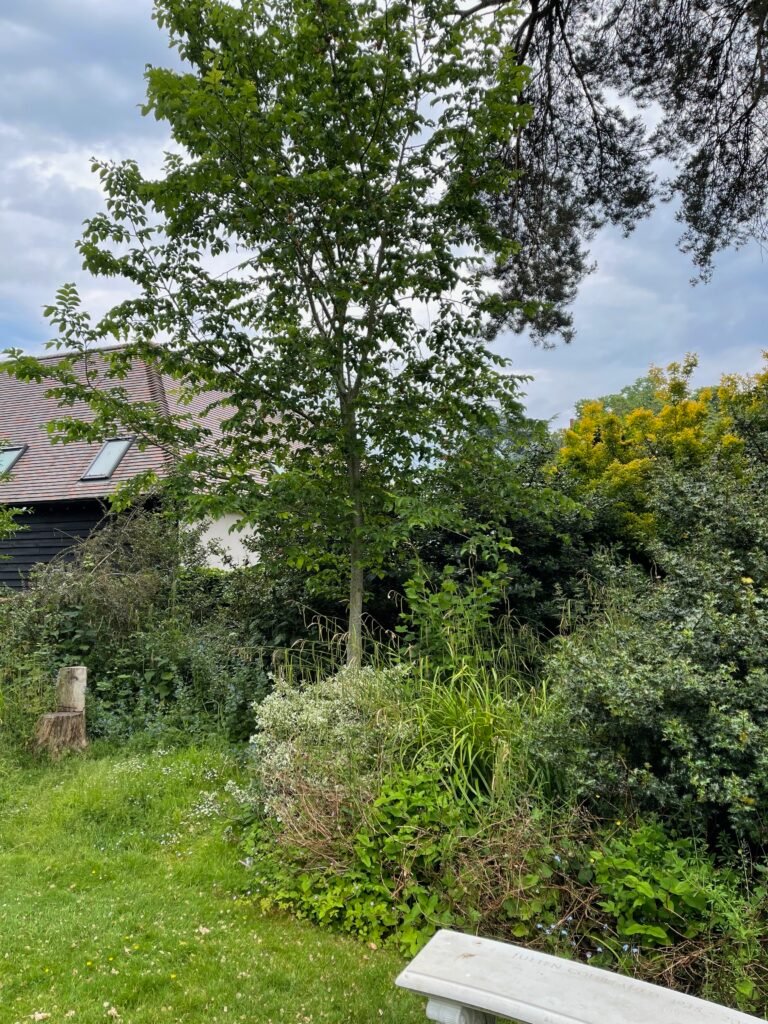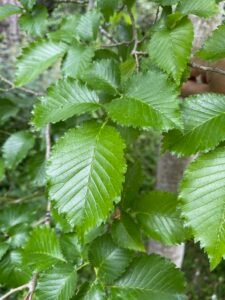Elm, English
The English Elm, is a deciduous tree, that can grow to a height of 30m, and may live more than 100 years.
The bark is grey-brown, rough and fissured, often with suckers growing from the base of the trunk. The twigs are finely hairy.

Photo supplied by: Alan Payne
Common Name:
English Elm
Scentific Name:
Ulmus procera
Tree No:
40a
Location:
I24

Smaller than those of the wych elm at 4–9cm in length. They are round to oval, toothed with a rough, hairy surface. They have the characteristic asymmetrical base that other elms have, and taper to a sudden point at the top.

Credit: Alan Payne
English elms are hermaphrodites, meaning both male and female reproductive parts are contained within the same flower. Flowers are dark pink to red and hang in tassels, appearing between February and March.

Credit: This could be your image
Once they’ve been pollinated by wind, the flowers develop into tiny winged fruits, known as samaras. These are dispersed by wind.

Credit: This could be your image
Despite its common name, it may have been introduced to the UK by Bronze Age farmers, or could be native to southern England only. In the past, English elm dominated the British landscape, but has been ravaged by Dutch elm disease since the 1960s. Now it is only found occasionally in hedgerows or woodland.
Elm grows best in well-drained soil in hedgerows and woodland. It can usually tolerate a range of pH levels in soil.
Many birds and some small mammals eat elm seeds and the leaves provide food for the caterpillars of many moths. Caterpillars of the white-letter hairstreak butterfly feed on elms and the species has declined dramatically since Dutch elm disease arrived in the UK.
Its timber was immensely valuable in making coffin boards, ships, piles for wharves and piers.
Elm wood is strong and durable with a tight-twisted grain, and is resistant to water. It has been used in decorative turning, and to make boats and boat parts, furniture, wheel hubs, wooden water pipes, floorboards and coffins.
Until 1967 the English Elm dominated the landscape of East Anglia and the whole of Britain. In that year a load of infected logs from North America brought a more virulent strain of Dutch Elm Disease to Britain.
This disease originally came to Europe in 1910 from Asia. It was isolated and named in Holland in 1921 but had largely died out by 1940. The new strain, carried by the Elm-bark Beetle, spread rapidly across Britain and by 1990 it had killed 25 million trees in the UK.
In the early nineties, it became clear that a number of mature elm trees in Essex had survived Dutch Elm Disease, despite all around them having succumbed. Local Tree Officer Melvyne Crow took some cuttings from these trees and deposited a few of them with Paul King, of King & Co.
Over a period of around 10 years Paul King potted them on, as the original trees were still in full leaf and realised that resistance to DED was increasingly likely. The decision was taken to investigate the best method of propagating these cuttings to produce good numbers of trees. Despite some difficulties, over 2000 “plugs” were eventually produced via micro-propagation. Since then, these trees have been grown on until reaching 10-12ft (3-3.7m) feet in height and are now established in 45 litre containers.
By the time these elm trees were released for sale in 2014, well over £75,000 had been spent on the project. Although it is unlikely that the trees are immune to DED, they do seem highly resistant to the disease. This may be because the main vector of DED, the Elm Bark Beetle, does not like feeding on the shiny, pendulous of this type of smooth leafed elm. The co-operation of Melvyne Crow and Paul King may well have saved the English Elm.
Tree Listings
Lucombe Oak
Oak, Lucombe The Lucombe Oak, is a large spreading semi-evergreen tree, that can grow to a height of over 20m, and may live for 240 years. The bark is thick and corky and is fire resistant. Branches on older trees can be quite chunky. The buds are brownish, ovate...
Holme Oak
Oak, Holme The Holm Oak, is a broadleaf evergreen tree, that can grow to a height of over 20m, and may live for 400 years. The crown is broad, domed, with ascending branches and often with low stems. The bark is black and finely cracked, and the twigs are slender and...
English Oak
Oak, English The English Oak, the majesty of the woods, is a broadleaved deciduous tree, that can grow to a height of 40m, and may live for 1,000 years. This species grows and matures to form a broad and spreading crown with sturdy branches beneath. Photo...
English Oak
Oak, English The English Oak, the majesty of the woods, is a broadleaved deciduous tree, that can grow to a height of 40m, and may live for 1,000 years. This species grows and matures to form a broad and spreading crown with sturdy branches beneath. This tree was...
Red Maple
Maple, Red The Red Maple, is a striking broadleaved deciduous tree, that can grow to a height of 20m, and may live for 200 years, although 80 to 100 years may be more typical. This tree was planted in memory of Mr Hungerford Rowley, a long and respected resident of...
Red Maple
Maple, Red The Red Maple, is a striking broadleaved deciduous tree, that can grow to a height of 20m, and may live for 200 years, although 80 to 100 years may be more typical. Photo supplied by: Alan PayneCommon Name:Red Maple Scentific Name:Acer rubrum Tree...
Norway Maple
Maple, Norway The Norway Maple, is a broadleaved deciduous tree, that can grow to a height of 25m, and may live for 150 years. The bark is grey with fine ridges, and the twigs are slender and brown with tiny white spots. Photo supplied by: Alan PayneCommon...
Norway Maple
Maple, Norway The Norway Maple, is a broadleaved deciduous tree, that can grow to a height of 25m, and may live for 150 years. The bark is grey with fine ridges, and the twigs are slender and brown with tiny white spots. Photo Supplied By: Alan PayneCommon...
Field Maple
Maple, Field The Field Maple, is a sturdy broadleaved deciduous tree, that can grow to a height of 20m, and may live for 350 years. The bark is light brown and flaky, and twigs are slender and brown and develop a corky bark with age. Small, grey leaf buds grow on long...
Common Lime
Lime, Common The Common Lime, a hybrid between small-leaved and large-leaved lime, is a broadleaved deciduous tree, that can grow to a height of 40m, and may live for 400 years. The bark is pale grey-brown and irregularly ridged, with characteristic large burrs and...
Horse Chestnut
Horse Chestnut The Horse Chestnut, with its shiny mahogany conkers, is a broadleaved deciduous tree, that can grow to a height of 40m, and may live for 300 years. The bark is smooth and pink-grey when young, which darkens and develops scaly plates with age. Twigs are...
Lawson Cypress
Cypress, Lawson The Lawson Cypress, is an evergreen conifer, that can grow to a height of 45m high, and may live more than 500 years. A tall, narrowly conical tree, with feathery foliage. The bark is cracked into vertical plates, and the twigs are a dark...
Braintree & Bocking Public Gardens,
43 Bocking End,
Braintree,
CM7 9AE.
Open 9:00 to 4:00pm – January, February.
Open 9:00 to 6:00pm – March.
Open 9:00 to 7:00pm – April.
Open 9:00 to 8:00pm – May, June, July, August.
Open 9:00 to 7:00pm – September.
Open 9:00 to 6:00pm – October.
Open 9:00 to 4:00pm – November December.
Note – The gates are locked at dusk.
Dusk is subject to seasonal variation, so closing times may not be exactly to the schedule, at the transitions.
No dogs allowed in the gardens.
No alcohol to be consumed in the gardens.
No riding of cycles or scooters in the gardens.
General Enquiries
Phone: 01376 773066
Email: info@braintreeandbockinggardens.co.uk
Tennis Enquiries
Phone: 01376 773070
Email: tennis@braintreeandbockinggardens.co.uk
© Braintree & Bocking Public Gardens Trust 2017-2021. All Rights Reserved.
Registered Charity Number 212989
Get in touch


Braintree and Bocking Public Gardens
We provide, maintain and preserve these unique and beautiful gardens as a community green space.